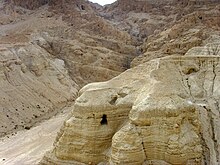 |
| Up on the web was a lonely goatherd... |
Google's partnership with the Shrine of the Book at the Israel Museum is making the Dead Sea Scrolls available to scholars and the public in a groundbreaking new way.
Realizing that the physical copies of these manuscripts from the Qumran community have a limited shelf life, the team is digitally archiving the collection. This is itself is important, and impressive. Their project is about much more than simple storage, though.
What makes this so exciting from the perspective of a biblical student and text critic is the fact that it the end result (according to the project's website)"gives users access to searchable, fast-loading, high-resolution images of the scrolls..."
In the era of Project Gutenberg, searchable pdf files, and advanced web crawling, this may not seem so impressive. Don't yawn though. This is a really, really big deal.
What this means is that texts that previously even the most respected scholars could never have dreamt of handling or studying for themselves are available - for free - to the general public. These texts are now fully searchable, and offer translation directly tied to the image being studied. This is a big deal.
Play around with the Great Isaiah Scroll for a sense of the project.
Part of my fascination with the scriptures has to do with the vulnerable, messy way that they have come to us. The story of the bible's development rambles and winds through millenia, through myriad ethnic and religious communities, across barriers of language, culture, race, and belief. We hold flaps of papyrus, bits of parchment and vellum as evidence of its antiquity, and use these to carefully compare to what we have today, to faithfully interpret the meaning of those texts.
This careful criticism holds profound implications for how we study, exegete, translate, and teach the scriptures. The Dead Sea Scrolls are a key part of that study.
Now that they are archived in the cultural and scholarly "commons" means that any student of the Bible's text and story can directly interact with these manuscripts for themselves, compare their conclusions with those of the wider community, and bring that story a bit closer to the narrative of their own lives.
It's my sincere hope that this project is a vision of "things to come" in ancient text criticism. Though the real beauty - and danger - lies in the interpretation of the manuscripts, having them within easy reach of anyone whose heart lies in the letters on that old paper is a really, really good idea.
And though they might not say it, the desert hermits of the Qumran community would probably be a bit jealous.
(Photo credit)

No comments:
Post a Comment